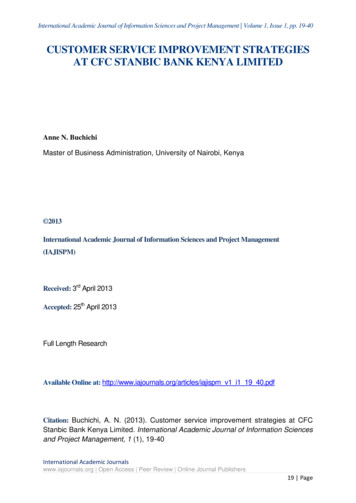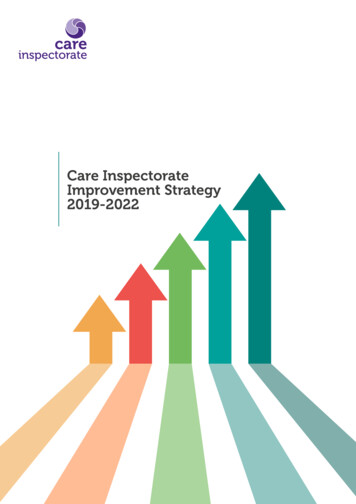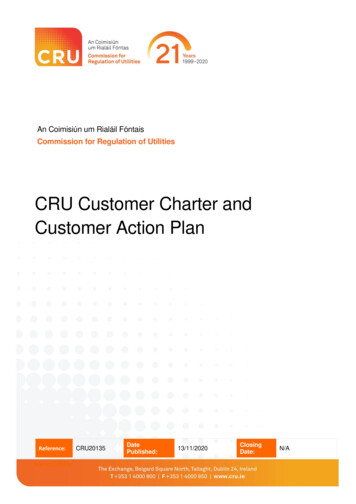
Transcription
International Academic Journal of Information Sciences and Project Management Volume 1, Issue 1, pp. 19-40CUSTOMER SERVICE IMPROVEMENT STRATEGIESAT CFC STANBIC BANK KENYA LIMITEDAnne N. BuchichiMaster of Business Administration, University of Nairobi, Kenya 2013International Academic Journal of Information Sciences and Project Management(IAJISPM)Received: 3rd April 2013Accepted: 25th April 2013Full Length ResearchAvailable Online at: http://www.iajournals.org/articles/iajispm v1 i1 19 40.pdfCitation: Buchichi, A. N. (2013). Customer service improvement strategies at CFCStanbic Bank Kenya Limited. International Academic Journal of Information Sciencesand Project Management, 1 (1), 19-40International Academic Journalswww.iajournals.org Open Access Peer Review Online Journal Publishers19 Page
International Academic Journal of Information Sciences and Project Management Volume 1, Issue 1, pp. 19-40ABSTRACTWith the increasing competition thatcompanies are facing today, rewards willaccrue to those who can read precisely whatconsumers wants by continuously scanningthe environment and delivering the greatestvalue to customers. This study sought toestablish the customer service improvementstrategies at CfCStanbic Bank KenyaLimited. The Bank had faced many servicedelivery challenges following the merger ofCFC Bank and Stanbic Bank of KenyaLimited. They two banks had a differentsetting, management and organizationculture. The study applied case studyresearch design where information was onlycollected from the senior management teamsince they are involved in strategyformulation and implementation. The studyused both primary and secondary data.Primary data was collected using interviewguide while secondary data was collectedusing desk research from publications at theBank. The study used content analysis andpresented the findings in prose format. Fromtheresearchfindings,customerimprovement strategies used by the Bank tosatisfy and retain customers includedharmonization of operating systems andbank account systems; harmonization ofATM networks and by becoming moreproactive and sensitive to customer issueswhich enabled it respond to customer needson time thus attracting more and increasingthe satisfaction level of the existing ones.The Bank engaged in intense research anddevelopment which led to the developmentof new banking services with features acustomized to certain market segment toappreciate the status of customers. The Bankused market segmentation and targetingstrategies to improve customer service andsatisfaction. The bank invested in employeecapacity building and culture managementto build a service culture among itsemployees. The study concluded that themerger of CFC Bank and Stanbic bank toform CFCStanbic Bank presented severalservice challenges to the Bank. To helpdeliver services efficiently to customers, theBank invested in Customer improvement toboost its customer satisfaction and loyalty.The Bank faced employee culture andorientation, system compatibility and changeagents inadequacy.Key Words: customer service, improvementstrategies, CFCStanbic Bank Kenya LimitedINTRODUCTIONToday, many organizations are faced with significant challenges in the area of customer serviceand service delivery, both internally and externally. The constant change in demographicscoupled with high customer expectations is making organizations rethink its customer servicestrategies. Strategies and tactics that worked in the past are less effective and require more effortto execute (Harrington and Akehurst, 2000). In an era where service has become a definingfactor for customers, organizations of all types struggle to find the unique balance betweendelivery of a service, the cost of the delivery and customer expectations.International Academic Journalswww.iajournals.org Open Access Peer Review Online Journal Publishers20 Page
International Academic Journal of Information Sciences and Project Management Volume 1, Issue 1, pp. 19-40Management needs to carefully and critically assess how their companies have performed atdeveloping and implementing a customer-focused service strategy. Customer service is acompetitive weapon that can easily differentiate one supplier from another. The discipline toadhere to a good customer service and operational strategy can create substantial rewards (Dalland Bailine, 2004). In most industries, customers have become more sophisticated anddemanding of their supply chains. Suppliers that offer the most in customer-defined qualityproducts, pricing and quick order turnaround will outperform their competitors and easily gainmore market share in the future as customers clamor for more. For management, a high level ofcustomer service must become a measurable result.Following the increased completion among commercial banks in Kenya, many banks have triedto gain competitive advantage through customer service. Customer service enables a bank todifferentiate its market segments for greater customer satisfaction and improved bankperformance. The products offered by different banks in Kenya are more less the same onlydifferentiated through packaging and other service additional. CFCStanbic has realized theimportance of this and has now embarked on customer service to meet its customers’ demands.This follows the 2008 merger between CFC Bank and Stanbic bank where customers from thetwo banks were brought together under CFCStanbic bank Limited.Concept of StrategyJohnson and Scholes (2002) defined strategy as the direction and scope of an organization overthe long term, which achieves advantage for the organization through its configuration of itsresources within a challenging environment and geared towards meeting the needs of the marketsas it fulfils stakeholder expectations. Porter (1996) asserts that strategy is creating a fit amongcompany's activities. The success of a strategy depends on doing many things well -not just afew- and integrating them. If there is no fit among activities, there is no distinctive strategy andlittle sustainability. The company's activities include its effective interaction with theenvironment in that these activities are geared towards serving the external environment.Since resources are scarce, managers must decide which alternative strategies will benefit thefirm most. For any organization to succeed, it will be necessary for top management, managersand employees to work as a team to achieve the company goals and objectives. According toPorter (1996), organizations must embark on making their strategies competitive. He argues thatcompetitive strategy is about being different which means deliberately choosing a different set ofactivities to deliver a unique mix of value. Porter argues that strategy is about competitiveposition, about an organization differentiating itself in the eyes of the customer, about addingvalue through a mix of activities different from those used by competitors.Customer Service Improvement StrategiesCustomer service is the provision of service to customers before, during and after a purchase.According to Turban et al. (2002) customer service is a series of activities designed to enhanceInternational Academic Journalswww.iajournals.org Open Access Peer Review Online Journal Publishers21 Page
International Academic Journal of Information Sciences and Project Management Volume 1, Issue 1, pp. 19-40the level of customer satisfaction that is, the feeling that a product or service has met thecustomer expectation. Customer service plays an important role in an organization's ability togenerate income and revenue (Selden, 1998). From that perspective, customer service should beincluded as part of an overall approach to systematic improvement. A customer serviceexperience can change the entire perception a customer has of the organization.Customer service is one of the most important ingredients of the marketing mix for products andservices. High quality customer service helps to create customer loyalty. Customers today are notonly interested in the product they are being offered but all the additional elements of service thatthey receive from the greeting they receive when they enter a retail outlet, to the refund and helpthat they receive when they have a complaint about a faulty product that they have paid for(Peppard, 2000). Well served customer will on most occasions pose certain compliments, adviceor unleash sudden relief in form of complaints over the previous substitute products defaults theyexperienced in a competitors field (Cook and Hababou, 2001).Mergers and acquisitions produce synergy, hence better use of complementary resources leadingto geographical or other diversification. This smoothens the earning of a company, which overthe long term smoothens its stock price, giving conservative investors more confidence ininvesting in the company. The primary purpose of merging and acquiring new firms is usually toimprove overall performance by achieving synergy, or the more commonly described as the 2 2 5'' effect (Cartwright and Cooper, 1993) between two business units that will increasecompetitive advantage (Weber et al., 1996). Kenya's financial sector witnessed failure of manybanks in the eighties and the nineties. After this period, banks as a reactive or proactive measureembarked on restructuring and among the approaches they used is merging and acquiringhorizontally. Among the recent mergers are CFC/Stanbic Bank merger, EABS-Akiba Bankmerger, and EABS/ECOBANK merger. The mergers have been aimed at strengthening thefinancial base of the resulting firm hence increasing its competitiveness.The Banking Sector in KenyaThe Banking industry in Kenya is governed by the Companies Act, the Banking Act, the CentralBank of Kenya Act and the various prudential guidelines issued by the Central Bank of Kenya(CBK). The banking sector was liberalised in 1995 and exchange controls lifted. The CBK,which falls under the Minister for Finance docket, is responsible for formulating andimplementing monetary policy and fostering the liquidity, solvency and proper functioning of thefinancial system. Kenya currently has 43 licensed commercial banks and one mortgage financecompany. Of these 44 institutions, 31 are locally owned and 13 are foreign owned. Citibank,Habib Bank and Barclays Bank are among the foreign-owned financial institutions in Kenya.The government of Kenya has a substantial stake in three of Kenya's commercial banks. Theremaining local commercial banks are largely family owned. Commercial banks in Kenya acceptdeposits from individuals and turn a profit by using the deposits to offer loans to businesses witha high interest rate.International Academic Journalswww.iajournals.org Open Access Peer Review Online Journal Publishers22 Page
International Academic Journal of Information Sciences and Project Management Volume 1, Issue 1, pp. 19-40Kenya is hailed as having the most resilient financial system of its neighbors and a matureprivate sector that welcomes foreign investors. Kenya's commercial banks play a crucial role inensuring Kenya's economic progress. In 1986, Kenya's financial sector experienced a crisis thatresulted in 37 failed banks. Loans in default were at the center of the financial crisis. To protectKenya's commercial banks from undergoing a similar crisis, the Parliament passed a series ofregulations to govern the banking industry, and the Central Bank of Kenya strengthened itsregulatory role. The Banking Act was amended in 1999, and installed a capital requirement (aminimum amount of liquidity available at all times) at commercial banks. Risk assessment andcredit rating agencies were also created in Kenya to govern the distribution of loans.CfC Stanbic Bank LtdCfCStanbic Bank, which is part of the Standard Bank Group, is now the fourth largest bank inKenya measured by total assets. The Standard Bank Group, which has its head office in SouthAfrica, is Africa’s largest bank by market capitalization and assets. At the end of 2007, theStandard Bank Group had total assets of over R 1,191 billion (approximately USD175.0 billion)and employed over 40,000 people worldwide. The Bank’s market capitalization as at 3 April2008 was R145 billion (approximately USD18.6 billion). CfCStanbic Bank was formed in June2008 out of a deal that brought together Stanbic Bank Kenya Ltd and CfC Bank Ltd, whichincludes CfC Bank, CfC Life, CfC Financial Services, Heritage Insurance and HeritageInsurance Tanzania. CfCStanbic Bank is a corporate and retail bank licensed by the Central Bankof Kenya to provide banking services in the Kenyan economy.At the core of CfCStanbic Bank’s values is a commitment to offer relevant and first classfinancial services within both the corporate and retail banking segments. CfCStanbic Bank hasover the years built a formidable reputation in the corporate and investment banking space andhas structured some of the East Africa Region’s largest and most important financialtransactions. Leveraging its regional, continental and global network, CfCStanbic Bank is thepremier service provider of international corporate and investment banking services and takespride in providing innovative financial solutions for Kenya’s growing retail banking population.CfCStanbic Bank is listed on the Nairobi Stock Exchange (NSE) and currently has a marketcapitalization of Sh11.7 billion (USD 129 Million) at November 28th 2011.RESEARCH PROBLEMWith the increasing competition that companies are facing today, rewards will accrue to thosewho can read precisely what consumers wants by continuously scanning the environment anddelivering the greatest value to customers. Evans (1987) is of the view that as the operatingenvironment changes; a more pronounced transformation of the business landscape lies ahead.As a result, businesses faced increased competition and registered low profits and even losses.This could probably be attributed to lack of customers’ satisfaction (Abdalla, 2001).International Academic Journalswww.iajournals.org Open Access Peer Review Online Journal Publishers23 Page
International Academic Journal of Information Sciences and Project Management Volume 1, Issue 1, pp. 19-40CfCStanbic bank on its part has faced a fair share of customer care issues following the 2008merger of CfC Bank Kenya Limited and Stanbic Bank Kenya Limited. The customers for thetwo banks were brought together under one bank where the two bank systems were notcompatible. This saw customers complaining as the Bank continued improving service deliveryto bring all customers under one system. The issue of customer satisfaction is of paramountimportance for any organization in any industry if it needs to beat the competitors in terms ofhaving repeat buyers. As the level of competition has intensified in the Banking sector due to themany players in the industry, it is important that the customers be treated well so that they can beloyal to the brand.Locally, studies that have been done include: Muriithi (1996) did analysis of customer serviceoffered by Kenya Commercial Bank where it was established that Kenya Commercial Bank waslosing customers because of the low quality of services offered in some of the branches. Inaddition, the customers complained of frequent ATM breakdowns and long queues whichconsumed their precious time; Mazrui (2003) studied the marketing approaches used bymanagers to address customer service challenges in banking in Kenya. It was established thatbanks used several strategies including segmentation and targeting, customer serviceimprovement and product development and market penetration. Mutuku (2006) did an empiricalinvestigation of the quality of customer service offered by Kenya’s Ministry of Finance. Fromthe above discussions and the background of the challenges that have faced CFCStanbic Bankfollowing the 2008 mergers, it was important that a study be done to establish the customerservice improvement strategies at the Bank. This study therefore sought to answer the question:What are customer service improvement strategies at CFCStanbic Bank Kenya Limited?RESEARCH OBJECTIVEThis study sought to establish the customer service improvement strategies at CfCStanbic BankKenya Limited.LITERATURE REVIEWConcept of StrategyStrategy can be defined as the direction and scope of an organization over the long term, whichachieves advantage for the organization through its configuration of its resources within achallenging environment and geared towards meeting the needs of the markets as it fulfilsstakeholder expectations according to (Johnson and Scholes, 2002). Ansoff (1990) definesstrategy as the product market scope of a company. This refers to a decision of what to producein what market. If the environment is stable, an organization can operate without changing itsproduct-market focus. However, if the environment changes, this would require changes in theorganization's product-market focus that is its strategy. Porter (1996) asserts that strategy iscreating a fit among company's activities. The success of a strategy depends on doing manythings well -not just a few- and integrating them. If there is no fit among activities, there is noInternational Academic Journalswww.iajournals.org Open Access Peer Review Online Journal Publishers24 Page
International Academic Journal of Information Sciences and Project Management Volume 1, Issue 1, pp. 19-40distinctive strategy and little sustainability. The company's activities include its effectiveinteraction with the environment in that these activities are geared towards serving the externalenvironment.A strategy reflects a company's awareness of how, where and when it should compete and forwhat purposes it should compete. The underlying issue of this definition is that the main thrust ofstrategy is to achieve long term sustainable advantage over the other competitors of theorganization in every business in which it participates. It recognizes that competitive advantageresults from a thorough understanding of the external forces that impact on the organization.According to Johnson and Scholes (2002), the term strategy gives the direction and scope of anorganization over the long term which achieves advantage for the organization through itsconfiguration of resources within changing environment to meet the needs of the market andfulfill stakeholders' expectations.Mintzberg (1999) identified five interrelated definitions of strategy as a plan, ploy, pattern,position and as a perspective. He does not argue that one definition should be preferred to theothers, but rather be considered as alternatives or complementary approaches. Since resourcesare scarce, managers must decide which alternative strategies will benefit the firm most. For anyorganization to succeed, it will be necessary for top management, managers and employees towork as a team to achieve the company goals and objectives.Customer Service Improvement StrategiesCustomer service is the provision of service to customers before, during and after a purchase.According to Turban (2002), Customer service is a series of activities designed to enhance thelevel of customer satisfaction – that is, the feeling that a product or service has met the customerexpectation. Its importance varies by products, industry and customer; defective or brokenmerchandise can be exchanged, often only with a receipt and within a specified time frame.Retail stores often have a desk or counter devoted to dealing with returns, exchanges andcomplaints, or will perform related functions at the point of sale; the perceived success of suchinteractions being dependent on employees "who can adjust themselves to the personality of theguest. According to Micah (2010) from the point of view of an overall sales process engineeringeffort, customer service plays an important role in an organization's ability to generate incomeand revenue (Selden, 1998). From that perspective, customer service should be included as partof an overall approach to systematic improvement. A customer service experience can changethe entire perception a customer has of the organization. Dall and Bailine (2004) have arguedthat the quality and level of customer service has decreased in recent years, and that this can beattributed to a lack of support or understanding at the executive and middle management levelsof a corporation and/or a customer service policy. To address this argument, many organizationshave employed a variety of methods to improve their customer satisfaction levels, and otherKPIs.International Academic Journalswww.iajournals.org Open Access Peer Review Online Journal Publishers25 Page
International Academic Journal of Information Sciences and Project Management Volume 1, Issue 1, pp. 19-40Because customers have more choices today and the targeted customers are most valuable to thecompany, customer service must receive a high priority within the company. In a general sense,any contact or "touch points" that a customer has with a firm is a customer service encounter andhas the potential either to gain repeat business and help CRM or to have the opposite effect.Programs designed to enhance customer service are normally of two types. Reactive service iswhere the customer has a problem (product failure, question about a bill, product return) andcontacts the company to solve it. Most companies today have established infrastructures to dealwith reactive service situations through telephone numbers, faxback systems, e-mail addresses,and a variety of other solutions. Proactive service is a different matter: this is a situation wherethe manager has decided not to wait for customers to contact the firm but to rather be aggressivein establishing a dialogue with customers prior to complaining or other behavior sparking areactive solution. This is more a matter of good account management where the sales force orother people dealing with specific customers are trained to reach out and anticipate customers'needs.Service quality has been defined as customers’ overall impressions of an organization’s servicesin terms of relative superiority or inferiority (Johnston, 1995). It should not only meet but alsoexceed customer expectations and should include a continuous improvement process (LloydWalker & Cheung, 1998). Customers evaluate banks’ performance mainly on the basis of theirpersonal contact and interaction (Grönroos, 1990). Judgments are formed by comparing serviceexpectations with the service actually received (Bloemer et al., 1998). Berry et al. (1985) andZeithaml and Bitner (1996) indicated that service quality consists of five dimensions: tangibles(appearance of physical facilities, equipment, personnel and written materials), reliability (abilityto perform the promised service dependably and accurately), responsiveness (willingness to helpcustomers and provide prompt service), assurance (knowledge and courtesy of employees andtheir ability to inspire trust and confidence), and empathy (caring and individual attention thefirm provides its customers). Reliability is considered the essential core of service quality. Otherdimensions will matter to customers only if a service is reliable, because those dimensionscannot compensate for unreliable service delivery (Berry et al., 1994).In terms of qualitative benefits, customer satisfaction and loyalty have been perceived as majorconcerns; it is widely accepted that a business must concentrate on pursuing service quality toachieve customer satisfaction because survival of the business greatly depends on thatsatisfaction (Naumann, 1995).Quality is the degree of excellence intended, and control of variability in achieving thatexcellence, in meeting the customer's requirements. Zeithaml, Parasuraman, and Berry (1990),mirror this definition in their Gap Model. The essence of the Gap Model is that the quality of aservice is defined by the gap between a customer’s expectations for the service and herperceptions about what was actually delivered. The higher the perceptions are relative to theexpectations, the higher the service quality will be. Zeithaml et al. go on to elaborate on how thisInternational Academic Journalswww.iajournals.org Open Access Peer Review Online Journal Publishers26 Page
International Academic Journal of Information Sciences and Project Management Volume 1, Issue 1, pp. 19-40gap can be the result of other internal gaps in the service delivery system and marketingfunctions of the service firm.Service Quality Improvement StrategiesThis pays attention to quality improvement, particularly from an operations perspective onchoices addressing how service can be delivered better, so as to increase the perceptions of thecustomer. Examining the service literature reveals the choice reflected in four primary themes,specifically, culture-based, design-based, variation-based, and failure-based improvementstrategies.Culture-Based ImprovementOne of the greatest sources of positive, or negative, perceptions of the service is derived from theinteraction between the service provider and the customer during the service encounter. Theproviders’ ability and willingness to be flexible according to customers’ needs, and to resolveany problems which occur promptly and without hassle, is a function of their training and theorganizational culture in which they operate. Hostage identified the importance of a service’semployees and culture as early as 1975 in his analysis of the success of Marriott Corporation.These thoughts are echoed fifteen years later by Albrecht (1990) who asserts that relative tostandards-based approaches, “culture-based approaches will ultimately emerge as more effectivefor the management of service.”Schneider (1986) addresses improving service culture through a focus on individual and grouppsychology. Berry, Zeithaml, and Parasuraman (1990); and Schneider and Chung (1993); add theimportance of employee selection and training; Schlesinger and Heskett (1991b); and Roth andJackson (1995) elaborate on this importance of investing in people, since even though genericoperations capabilities affect service quality, the employee’s ability to exploit technology andmarket insight moderates this effect. Harrington and Akehurst (2000) confirm the importance ofemployee resourcefulness as well as senior management commitment to quality implementation.Hartline, Maxham and McKee (2000) discuss how a customer-oriented strategy from seniormanagement can be disseminated to the front-line employees through specific controlmechanisms.Kingman-Brundage (1991) emphasizes the need to provide technology to support the serviceculture. He asserts the importance of the service logic being consistent with the service policies,so as not to induce customer frustration. Schlesinger and Heskett (1991a) further develop asystem dynamics model to explain the feedback relationships between organizational variablesthat cause poor service culture and result in service failures. The system dynamics modelindicates that poor culture is the result of two positive feedback loops, meaning that it will getworse at an increasing rate. The authors identify points of leverage in the system where the cyclecan be reversed by management intervention. Georgantzas and Madu (1994) presented their ownversion of such a system dynamics model. Hartline and Ferrell (1996) investigate the interfacesInternational Academic Journalswww.iajournals.org Open Access Peer Review Online Journal Publishers27 Page
International Academic Journal of Information Sciences and Project Management Volume 1, Issue 1, pp. 19-40of the service delivery process (manager-employee, employee role, and employee-customer) andfind that managers should decrease employee’s role conflict and ambiguity, and increase selfefficacy and job satisfaction in order to increase customers’ perceptions of service quality.Schneider, White and Paul (1998) indicate that in addition to a climate for service, policies andpractices that focus attention on service quality are needed.Design-Based ImprovementAnother major service quality improvement approach is by addressing quality through design bylinking the design to customer needs, linking the design to customer perceptions, and directpsychological manipulation of satisfaction through design.The first structured approach to linking the service system design to customer’s needs wasHeskett’s (1987) strategic service vision. Heskett indicates how a service should begin with anunderstanding of the target market. This understanding is used to derive a service concept, astrategy for delivering on the key points of this strategy is developed, and the strategy ultimatelydictates the design of the service delivery system. Behara and Chase (1991) take a slightly morequantitative approach, by combining quality function deployment (QFD) with SERVQUAL andproducing what they refer to as a house of service. The result is a matrix that links the needs ofthe customer to operating design variables under the control of the system designer.Applications of quality function deployment without the SERVQUAL component are also seenin services. Berkley (1996) takes a particularly rigorous approach to service QFD, using FASTdiagrams to draw connections along the means-ends hierarchy, and morphology diagrams for theselection of appropriate technologies. The most quantitatively advanced approach to assuringthat the customers’ needs are met by the service design is through the use of conjoint analysis (agood discussion of which can be found in Green and Srinivasan, 1990.) Probably the mostwidely know application of this technique was Wind, Green, Shifflet and Scarbrough’s (1989)design of the Courtyard by Marriott hotel chain. Through conjoint analysis, the authors were ableto assign a dollar value to each design option, based on the willingness of t
merger, and EABS/ECOBANK merger. The mergers have been aimed at strengthening the financial base of the resulting firm hence increasing its competitiveness. The Banking Sector in Kenya The Banking industry in Kenya is governed by the Companies Act, the Banking Act, the Central Bank of Kenya Act and the various prudential guidelines issued by the Central Bank of Kenya (CBK). The banking sector .











